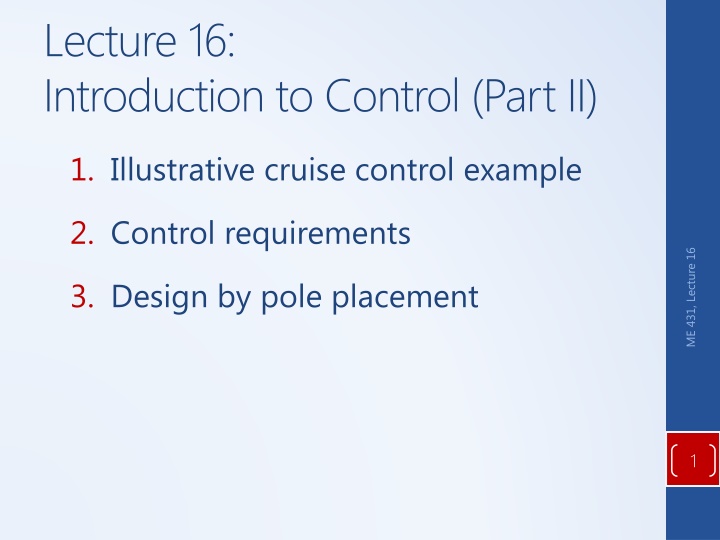
Advanced Cruise Control System Design and Analysis
Explore advanced concepts in cruise control system design and analysis, covering control requirements, pole placement design, transfer functions, closed-loop systems, controllers, and performance optimization through proportional, integral, and derivative (PID) control. Learn how to enhance system stability, robustness, speed, and responsiveness.
Download Presentation

Please find below an Image/Link to download the presentation.
The content on the website is provided AS IS for your information and personal use only. It may not be sold, licensed, or shared on other websites without obtaining consent from the author. If you encounter any issues during the download, it is possible that the publisher has removed the file from their server.
You are allowed to download the files provided on this website for personal or commercial use, subject to the condition that they are used lawfully. All files are the property of their respective owners.
The content on the website is provided AS IS for your information and personal use only. It may not be sold, licensed, or shared on other websites without obtaining consent from the author.
E N D
Presentation Transcript
Lecture 16: Introduction to Control (Part II) 1. Illustrative cruise control example 2. Control requirements ME 431, Lecture 16 3. Design by pole placement 1
Cruise Control Example F = control input (road force, generated by engine indirectly) f(v) F v = output (velocity of car) ME 431, Lecture 16 f(v)= friction/drag force Equation of Motion mv bv = = F F bv + mv = F 2
Cruise Control Example Transfer function ( ) msV s bV s + = = DC gain 1/ m b b first-order response = ( ) ( ) F s / ( ) ( ) 1 1/ / ) V s F s b = = ME 431, Lecture 16 + + ( 1 ms b m b s 1 3 + ms b v F
Cruise Control Example Response is stable (which is good) Not robust to disturbances, uncertainties May not be fast enough How to make better? Add control! ME 431, Lecture 16 controller plant 4 Control law is f=Ke, applied force is proportional to the error
Cruise Control Example Closed-loop transfer function K ( ) ( ) V s R s forward loop + + ms + b ME 431, Lecture 16 = = K 1 1 + ms K b m K + b K + = DC gain K + b K K = = + + ms b K m + + 1 s = b 5 b K
Cruise Control Example Making K larger makes system faster and DC gain closer to 1 both are generally desirable Any drawbacks? Eventually actuator will saturate Higher-order dynamics have been neglected (sensors, actuators), large K often will increase oscillation Large K can amplify unwanted inputs (like noise) ME 431, Lecture 16 K + + ( ) ( ) V s N s forward loop + K + ms b = = = K 1 ms b K + 6 1 + ms b Can we do better by trying a more complicated controller?
Cruise Control Example In the preceding, the control was proportional to the error called a P (proportional) controller Can add terms for the integral of the error (I) and the derivative of the error (D) ME 431, Lecture 16 1 s = + + ( ) C s K K K s P I D Each term of the PID controller changes system performance in a different way 7
Control Requirements Approach to control design: Translate engineering specifications into control requirements, then design a controller to meet those specifications Example transient specifications , Mp, tp, ts, tr Example steady-state specifications Typically it is required that steady-state error be less than some amount, ess< 0.02 Can use F.V.T. for different types of reference inputs ME 431, Lecture 16 = 8 lim ( ) e sE s 0 ss s
Pole Placement Poles of a system affect the time response Choose controller gains (for ex. KP, KI, and KD) so that poles of the closed-loop system meet given requirements ME 431, Lecture 16 If system is simple (first order, or second order) can employ algebra Process is generally iterative 9
Example Find the closed-loop transfer function for a cruise control system with PI controller
?(?) ????(?)= ??? + ?? Example (continued) ??2+ ? + ??? + ?? With two parameters (KP and KI) can place poles of this second-order system anywhere we like (2 d.o.f.) What is the effect of changing the control gains?
?(?) ????(?)=1 ??? + ?? Example (continued) ? ?2+ ? ? + ??/? + ??/? Let m=5 and b=1. Choose KP and KI to achieve a settling time of 2 seconds and a peak time of 1 second.
?(?) ????(?)=1 ??? + ?? Example (continued) 5 ?2+ ? 1 + ??/5 + ??/5 Will the closed-loop system with this controller actually have a settling time of 2 seconds and a peak time of 1 second?












